Archive for the 'Pears' Category
Last weekend, I harvested about 130 pears from our Comice pear tree. They are now in our extra refrigerator chilling for a month before I will take them out to fully ripen at room temperature. Our Comice pear tree is looking much healthier today than it did in past years. Once diffence is that I have been watering it 6 days a week. This tree seems to require lots of water, at least in our dry summer climate. In past years, I watered it 2-3 days a week, and the tree typically lost most of its leaves by September. This year, it has dropped many leaves already, but it still has most of its leaves now.

I am finally harvesting egggplants from our garden. I didn’t pick the first eggplants until late August, and it wasn’t until early September that I harvested several eggplants at once. Eggplants seem to thrive in warm weather. We have had relatively warm weather since early August, and our eggplants have been doing reasonably well since then.
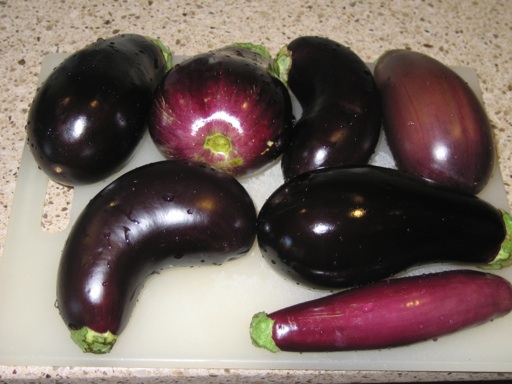

September 30 2013 | Eggplant and Pears | Comments Off on Fall Eggplants and Pears
We grow over a dozen different kinds of fruit trees and berries in our yard, including apricots, apples, figs, plums, pears, pluots, peaches, cherries, oranges, blackberries, strawberries, blueberries, and raspberries. Not all of our fruit trees produce fruit every year, and each type of fruit has a limited season. But because we have so many fruits, we typically have fruit to eat from our yard from May through September. Most of the fruit production occurs in our yard in mid-summer, so we have an abundance of fruit in the months of July and August.
This week, I have been harvesting Elephant Heart plums from our multi-grafted plum tree, shown in the photo below. The skin of these plums can be quite sour, at least until the fruit is almost mushy, but the pulp has a nice flavor.

Our small Bartlett pear tree is loaded with at least 100 pears this year (photos of it below). I have picked over 30 pears from it already, but I’ve not eaten any of them yet. Pears are harvested while still green and unripe. They are ready to harvest if the fruit separates from the branch easily when the fruit is lifted by hand into a horizontal position. The pears from this tree have been exquisite in past years. Although, our tree typically only produces pears every other year.
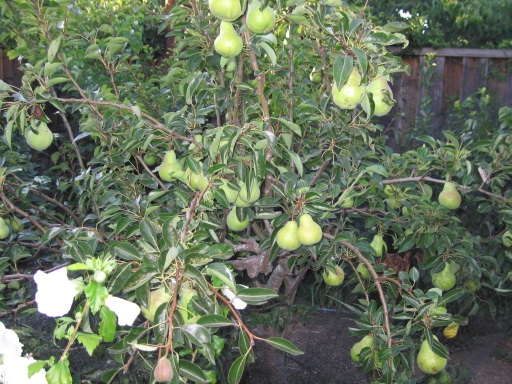

I am also harvesting Flavor King and Dapple Dandy pluots from our multi-grafted pluot tree. The first photo below is Flavor King (purple fruit), and the second photo is Dapple Dandy (pink fruit). I’m supporting the thin branches of this small tree with tomato cages, because there is too much fruit even after I thinned them. Also, the fruit is large (larger than last year’s harvest). I also have to protect them and my other fruit with netting.
Our pluot tree is one of my favorite fruit trees. Its fruits are delicious. Flavor King is perhaps one of the tastiest fruits I have eaten, even though plums in general are not my favorite fruit. Each of the 4 pluot varieties on our tree is unique in terms of its color, flavor, ripening time, and keeping quality. The other two varieties are Flavor Queen and Flavor Supreme. Dapple Dandy is a good variety, because it produces a lot of fruit, and the fruit holds well on the tree for several weeks.
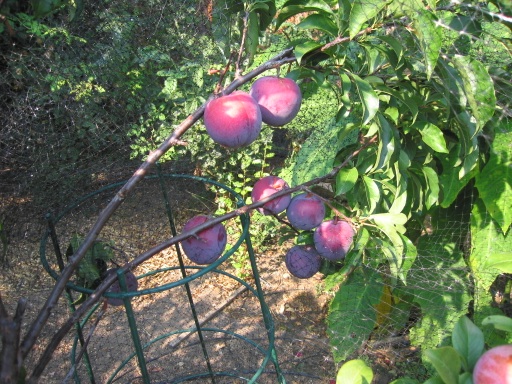
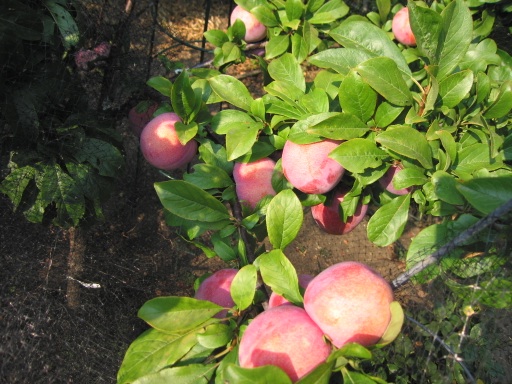
We also have a Caroline red raspberry plant that is growing in a large pot. Its canes are full of luscious looking raspberries right now, as shown in the next photo below. Unfortunately, our raspberries are not edible, because the insides of the berries are full of insect larvae that resemble very small white worms. Nearly all of the berries I have picked in the past week are full of the worms, and it’s not practical to remove them all. Although they may not be harmful if consumed, they are not appetizing.

July 29 2013 | Pears and Plums and Pluots and Raspberries | Comments Off on Mid-Summer Fruit

When I first moved into the house I live in, there was a small tree growing near the side door of the garage, crammed into a 2-foot strip between the house and a concrete pathway. The tree produced large fuzzy yellow fruits in the fall that resembled apples. I eventually discovered that the fuzzy yellow fruits were quinces. It turns out quinces are so sour they can’t be eaten fresh. They are mainly used to make jams and jellies.
In any event, I noticed some scrawny branches were growing from the bottom of the tree that had different looking leaves than the quince. I was able to identify those branches as pear branches, because there are two other pear trees on the property that had the same type of leaves. After doing some research, I figured out that the previous owners of the property had intended to plant a third pear tree, not a quince. It turns out that pear scions are often grafted onto quince rootstocks. However, rootstocks often grow suckers. If the suckers are not cut back, they can grow into a tree and eventually kill the scion.
After deciding we’d rather have another pear tree than a quince tree, we cut back the quince sucker to near where the pear scion was grafted onto it. That was about 3 or 4 years ago. Since then, the pear scion has grown considerably and produced pears. It bloomed during the quince years, but it never set any fruit. This year, it has produced about 20 pears (see above picture), which is impressive for such a small tree. The quince was a vigorous grower, so I think the tree developed a substantial root system prior to when we finally cut back the quince sucker.
A few years ago, I realized that this pear tree was producing two different looking types of pears. One type of pear was thinner in shape and ripened in August. It looked and tasted like a Bartlett pear. The other type of pear was fatter in shape, had a different color skin, and ripened much later. It looked and tasted like a Comice pear. So it turns out this tree is a multi-grafted pear tree. It was an interesting choice, because the two other pear trees on the property that were planted by the previous owners are a Bartlett and a Comice. Somebody really liked pears, which is fine with me because I really like them too. Most of the pears in this picture are Bartlett pears.
August 10 2012 | Pears | Comments Off on Multi-grafted Pear Tree
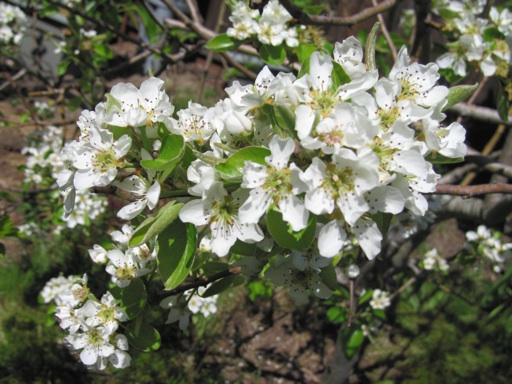


Our Comice and Barlett pear trees are full of blooms right now. The Bartlett pear tree (second picture) seems to have more blossoms than it has ever had. Even our 3 year old red Bartlett pear has blooms for the first time. Our pear trees consistently produce a crop of pears that is proportional to their spring bloom. The Bartlett in particular gets pears every time it blooms, unlike our Blenheim apricot tree, which was full of blooms in early March, but has no fruit on it now. The heavy rains we had here in mid-March seem to have damaged the newly forming apricots. Although, in some past years, our Bartlett pear tree did not have any blooms.
The newly forming fruit on pear trees seems to be less affected by rain than other fruits like apricots and sweet cherries. However, Comice and Bartlett pears are of course prone to fireblight which can cause severe branch die back and can reduce the crop. Although our pears have had touches of fireblight in past years, it has never affected more than a few branches on each tree. In general, fireblight is not a serious problem in our area, because the month of April when pears bloom here tends to be relatively dry.
April 16 2011 | Pears | Comments Off on Pear Blossoms
This week, I harvested the pears from the small Bartlett pear tree in our backyard. After about a dozen pears had fallen off, I figured many of the pears still on the tree were ready to be picked. Plus, Bartlett pears typically are ready to harvest around the second or third week of August in the Bay Area. I use the technique of lifting up each pear in a horizontal position to determine if it is ready to pick. If the pear comes off easily from the branch, it is ready to harvest. If not, I leave it on the tree.
Like other pears, Bartlett pears need to be picked when they are not completely ripe, because they ripen from the inside out. Unlike Comice and Anjou, Bartlett pears can be left at room temperature to fully ripen after harvest.
Bartlett pears are one of the best tasting pears. They are right up there with Comice in flavor, although Comice is sweeter. Home grown Bartlett pears are better tasting and sweeter than most supermarket Bartlett pears, in my opinion. Some supermarket Bartlett pears are very good, but others are dry inside and/or lacking in flavor. I wonder if that’s because growers prefer to pick all of their pears at once, regardless of whether each pear is at its ideal point for picking to maximize its flavor when it subsequently finishes ripening indoors. When you grow pears at home, it is more feasible to test each pear individually before you pick it to make sure it is at its ideal picking time.
Our Bartlett tree didn’t have any pears last year. It is the poster child for an alternate bearing fruit tree. It has only produced more than a few pears in even numbered years. It takes a year off in the odd numbered years. Fertilizing it with an all-purpose fertilizer once or twice a year hasn’t changed that.
Here are some pictures of our bartlett pear tree that I took today after partially removing the bird netting I placed around it about a month ago.

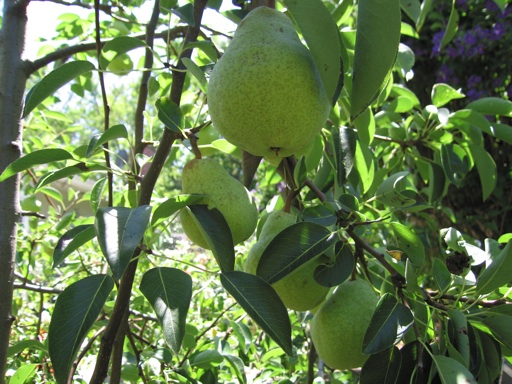
Below is a picture of most of the 110 pears I picked from our Bartlett pear tree. In 2008, picked about 130 pears from the same tree. That year, most of the pears were small, about half to two-thirds the size of supermarket pears. In 2009, I pruned the tree a lot, which seems to have limited it’s production a bit. However, the average size of the pears is larger this year. Many of them are supermarket size.
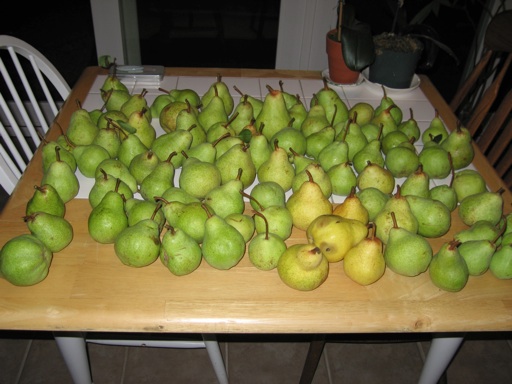
August 12 2010 | Pears | Comments Off on Bartlett Pears are Here Again
Next »















